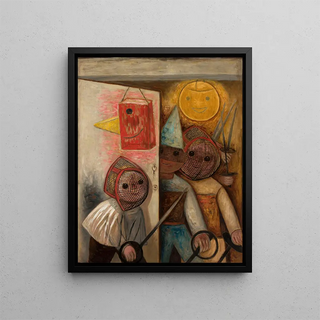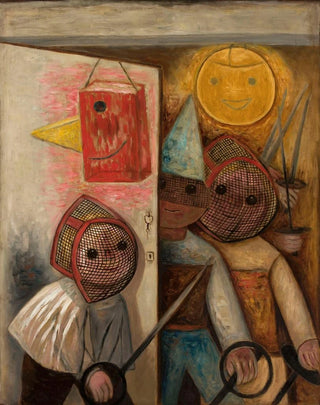Art print | Épéistes - Tadeusz Makowski


View from behind

Frame (optional)
Épéistes - Tadeusz Makowski – Captivating Introduction
In the fascinating universe of art, some works manage to capture the very essence of their era while transcending time. "Épéistes - Tadeusz Makowski" is one of those creations that evoke a world where bravery and aesthetics meet. This piece, both powerful and delicate, immerses us in a universe where every detail tells a story. Through the depiction of characters in full action, Makowski invites us to explore themes of struggle, camaraderie, and the beauty of movement. The dynamism of this work, where the figures seem almost to dance, reminds us that art is a universal language capable of touching souls.
Style and uniqueness of the work
Tadeusz Makowski's work stands out for its unique style, blending influences of cubism and fauvism. "Épéistes" is a perfect illustration of this fusion, where form and color intertwine to create a vibrant atmosphere. The bright, almost dazzling colors reinforce the energy emanating from the characters, while angular lines add a dimension of movement. Each épéiste, with their focused expression, appears frozen in a moment of palpable tension, capturing the viewer's attention. This dynamic representation, both realistic and stylized, demonstrates Makowski's skill in marrying technique with emotion. Upon closer inspection, subtle details, delicate shadows, and play of light enrich the composition, revealing the depth of the artist's artistic vision.
The artist and his influence
Tadeusz Makowski, born in Poland in 1882, established himself as an essential figure in modern art. Influenced by his travels in France and his encounters with avant-garde artists, he developed a style that is uniquely his own, oscillating between tradition and innovation. His passion for depicting everyday life and scenes of combat, as exemplified by "Épéistes," reflects a deep sensitivity towards humanity. Makowski was also marked by the tumult of his time, and his works often carry a strong emotional charge, bearing witness to the trials and struggles of his contemporaries.

Matte finish

View from behind

Frame (optional)
Épéistes - Tadeusz Makowski – Captivating Introduction
In the fascinating universe of art, some works manage to capture the very essence of their era while transcending time. "Épéistes - Tadeusz Makowski" is one of those creations that evoke a world where bravery and aesthetics meet. This piece, both powerful and delicate, immerses us in a universe where every detail tells a story. Through the depiction of characters in full action, Makowski invites us to explore themes of struggle, camaraderie, and the beauty of movement. The dynamism of this work, where the figures seem almost to dance, reminds us that art is a universal language capable of touching souls.
Style and uniqueness of the work
Tadeusz Makowski's work stands out for its unique style, blending influences of cubism and fauvism. "Épéistes" is a perfect illustration of this fusion, where form and color intertwine to create a vibrant atmosphere. The bright, almost dazzling colors reinforce the energy emanating from the characters, while angular lines add a dimension of movement. Each épéiste, with their focused expression, appears frozen in a moment of palpable tension, capturing the viewer's attention. This dynamic representation, both realistic and stylized, demonstrates Makowski's skill in marrying technique with emotion. Upon closer inspection, subtle details, delicate shadows, and play of light enrich the composition, revealing the depth of the artist's artistic vision.
The artist and his influence
Tadeusz Makowski, born in Poland in 1882, established himself as an essential figure in modern art. Influenced by his travels in France and his encounters with avant-garde artists, he developed a style that is uniquely his own, oscillating between tradition and innovation. His passion for depicting everyday life and scenes of combat, as exemplified by "Épéistes," reflects a deep sensitivity towards humanity. Makowski was also marked by the tumult of his time, and his works often carry a strong emotional charge, bearing witness to the trials and struggles of his contemporaries.






